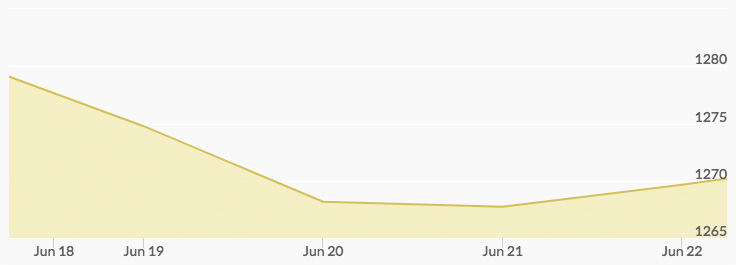
As the global trade conflict escalated last week, gold quietly battled a war of its own against the dollar. While gold hasn’t lost its safe haven status, the stronger dollar made it more expensive for foreign investors to protect their portfolios with the precious metal. The greenback may have the Fed on its side, but gold’s allies—the trade war and inflation—are gaining momentum and will likely prove more powerful contenders. Until the win comes, spot gold prices could be caught in the middle of these major market forces.
Read more about gold’s traditional market movers in “How These 10 Factors Regularly Influence Gold Prices.”
Gold Price Movement Indicators:
Monday, June 18, 2018
Stronger Dollar
Monday’s trading opened with the dollar stronger following the Fed’s interest rate hike on June 13 and the European Central Bank’s announcement on June 14 to tighten its monetary policy, which caused the euro to drop against the dollar. The greenback tends to be inversely correlated to gold. Although gold prices initially bucked this trend, by Monday the
pattern had taken hold, evidenced by the low of $1,277.70 hit at noon.
Trade War
Geo-economic risk typically fuels safe haven demand, but gold got lumped in with other commodities in a major selloff.[1] Investors in Shanghai certainly could have used some of gold’s financial insurance as prices for Chinese iron, ore, and rubber plummeted. ‘People are selling off their assets as the trade war escalates, which could affect the whole economy and would be the biggest bearish news since China opened up its doors to the world decades ago,’ asserted Fortune Bay Resources trade director Henry Chen.
By Monday night, the bears were ravaging the stock market. Investors ran to the safety of gold, pushing prices to a high of $1,283 at 11 pm.
Tuesday, June 19, 2018
Trade War
‘There is a bit of panic as investors are looking for cover, especially from equities market, and as we know gold does offer that hedge,’ said the head of trading at OANDA Stephen Innes on Tuesday. Market sentiment finally shifted when President Trump threatened another 10 percent tariff on $200 billion in goods if China slapped the U.S. with the retaliatory tariffs it promised the Friday prior. As the tit-for-tat trade war raged on, investors jettisoned stocks, causing the Dow to fall 287.26 points. Its 2018 yearly gains were wiped out.[2]
Gold prices rallied to the high for the week of $1,283.30 at midnight.
Wednesday, June 20, 2018
Hawkish Federal Reserve
Fed Chairman Jerome Powell took control of the economic narrative in a speech he gave at the European Central Bank conference in Portugal on Wednesday. While he acknowledged parallels between now and the 1970s—specifically the tight labor market—Powell argued that the U.S. economy would not suffer the same scourge of inflation because of greater central bank insight into the problem and policies to contain it. He also confirmed what investors had been speculating about for weeks, ‘The case for continued increases in the federal funds rate is strong.’
With these words, Powell stoked investors’ appetite for risk. Equities and the dollar rose as gold pulled back to a low of $1,266.10 at 11 pm.
Central Bank Gold Buying
The world’s central banks may be tightening their monetary policies in response to a stronger global economy, but they’re also buying gold as if the next crash were coming tomorrow. On Wednesday, Bloomberg reported that Kyrgyzstan, the tiny nation bordering China and Russia, nearly rivals Russia in national gold holdings. The country’s goal is to invest half its reserves in bullion. ‘It doesn’t matter what currencies we have in our reserves; dollars, yuan or rubles all make us vulnerable,’ said Kyrgyz central bank Governor Tolkunbek Abdygulov.
Larger players have been in the gold game for longer. Russia has more than tripled its gold reserves from 600 tons to about 2,000 tons in the last ten years. The exact scope of China’s gold hoarding is harder to pin down due to the nation’s secretive buying practices.[3] Which central bank has the most gold? The Fed of course.
Prices for the yellow metal peaked to $1,275 at 9 am.
Thursday, June 21, 2018
Weaker Dollar
The Fed may be saying the economy is doing swell, but data it released Thursday indicated otherwise: business activity in the Mid-Atlantic region fell to a nearly one-and-a half year low, reported the Philadelphia branch. Investors changed course from the day prior, and profit taking knocked the greenback off its eleven-month high.[4]
Dollar dips present opportunities for foreign investors to buy gold and silver at lower prices. Demand was slightly impacted, with the price of gold climbing from $1,262 at 3 am to $1,269.30 at 2 pm.
Friday, June 22, 2018
Trade War
The global trade war heated up on another front on Friday when President Trump took to Twitter to threaten Europe with a 20 percent tax on automobiles. The move was a response to Europe’s retaliation against the steel and aluminum tariffs the U.S. recently imposed; the E.U. went straight for the red state jugular by slapping a tariff on Harley Davidson motorcycles and Levi’s jeans. Bourbon from Senate Majority Leader Mitch McConnell’s home state of Kentucky, cranberries from House Speaker Paul D. Ryan’s birthplace of Wisconsin, and orange juice from swing state Florida were also on the list.
Gold gained slightly on the news, rising from $1,267 at 1 am to the high of $1,269.90 at 3 am.


